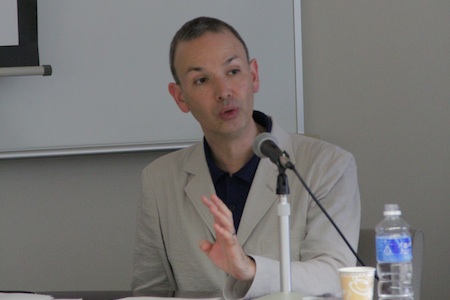[Report] Lecture by Prof. Akira Mizuta Lippit "Medium Disaster 311"
On June 26, Akira Mizuta Lippit (University of Southern California) gave a presentation entitled "Medium Disaster 311".
Prof. Lippit's research covers world cinemas, critical theory, Japanese film and culture, experimental film and video, and visual studies.

In this presentation, Akira Lippit examines recent Japanese cinema in light of the three-part disaster that has come to be known as "311". What, he asks, are the multiple media and historical resonances that find expression in discourses on 311, and in which respects has Japanese cinema anticipated these discourses? Here, Lippit introduces the notion of a "medium disaster", embedded in traces of Japanese history, and in dimensions of visual media.
Through a reading of Maurice Blanchot and Jean-Luc Nancy, Lippit examines Kurosawa Akira's Dreams (1990) and Kore-eda Hirokazu's After Life (1998). For Lippit, these films have a certain superficial quality, or could be said to embody a "cinema of surfaces". This is not a pejorative judgment, but rather an observation concerning the engagement with time and history offered by these films, as well as how they locate themselves in relation to a temporality of disaster. While both films preceded the 311 disaster by a number of years, in a sense they repeatedly prepare their spectators for disaster, or, in Lippit's words, prepare them for the return of a disaster that never fully disappeared. This is evident in the astonishing sequence of Kurosawa's Dreams, in which six nuclear reactors explode beyond the horizon of Fuji-san, a catastrophic image of the entire mountain threatening to collapse.

One of the broader contexts for Lippit's exploration is a critique of globalization, framed in terms of a problematic concerning how we think about the notion of a world. Through Derrida's reading of Crusoe and solitude, and a critique of Heidegger's concept of Welt, Lippit explores the simultaneously physical and metaphysical discourses of "worlding". What are the limits of the discourse of "a world", its finitude, or end? Is it that, at its limits, there is "no world, only islands"?
These questions bear directly on the nuclear and "medium disaster" of 311, insofar as it is both a national and non-national event. Despite the various assurances offered by the Japanese government, there is, clearly, no containment of such a nuclear event in space or time. While some of these questions have been addressed by Francis Ferguson in "Nuclear Criticism", or the general problematic of the "nuclear sublime", Lippit brings them into a highly original reflection on the place of media in the representation of disaster, as a matter of representing the world, or contact between worlds.






